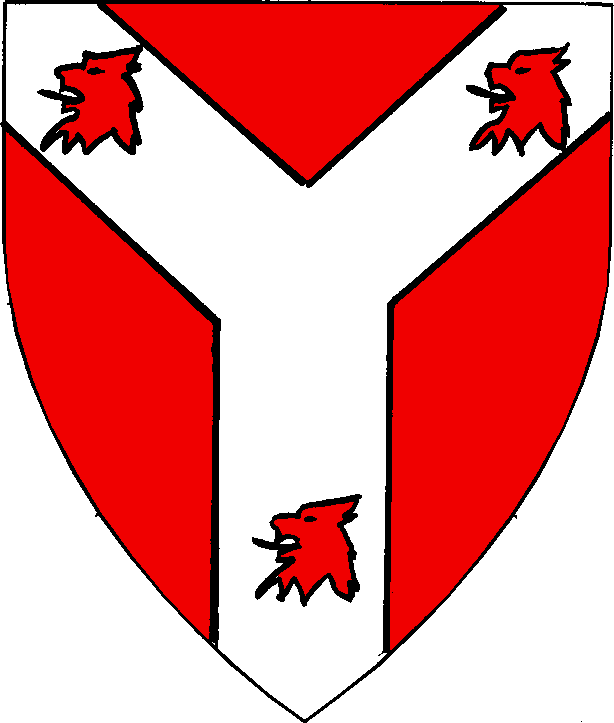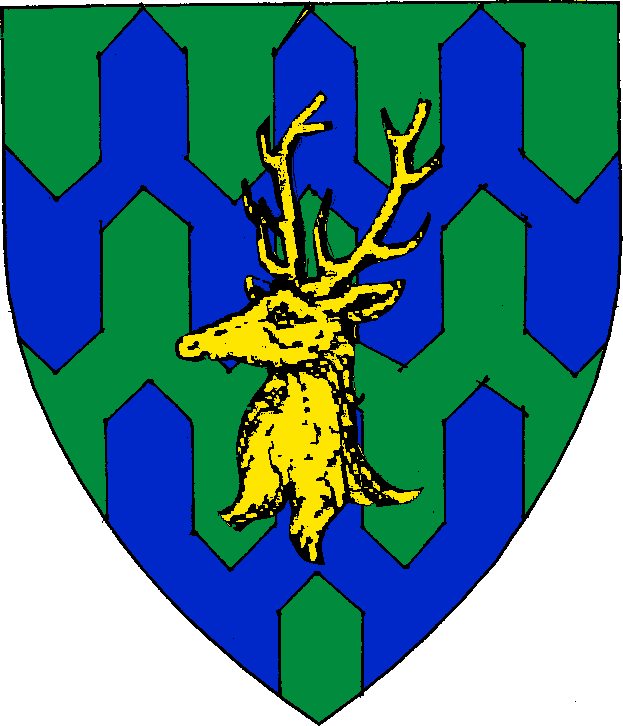


Crux Australis Herald
Baron Uberto Renaldi [mka Nigel Castle]
GPO Box 2719, Adelaide SA 5001, Australia
phone: (08) 8336 6791 or intl +618 8336 6791
 |
Crux Australis Herald Baron Uberto Renaldi [mka Nigel Castle] GPO Box 2719, Adelaide SA 5001, Australia phone: (08) 8336 6791 or intl +618 8336 6791 |
"The CAMeL"
May 2000 (A.S. XXXIV)
Unto the College of Heralds of the Principality of Lochac, and all others who may read this missive, from Baron Uberto Renaldi, Crux Australis Herald, greetings!
In this issue…..
Midwinter Investitiure | Internal commentary via email | Rolls of Arms competition reminder
Reports | Roster changes | Important addresses
Subscriptions and Resources | Submission requirements | Meeting schedule
Recent submissions | News of previous submissions | Articles on Court Heraldry (Part I)
Congratulations to Boris and Constance, who will succeed Cornelius and Morwynna as the 33rd Prince and Princess of Lochac.
As you have probably already heard, the Kingdom Poll returned a 'yes' vote. Exactly what this means for the College of Heralds will be detailed in next month's Camel, but suffice to say there will be a fair amount of work involved and I will need volunteers to do some of it. Watch this space.
Finally, as promised last issue this Camel is the first of two which will focus on court heraldry. The relevant articles have been put after 'News of previous submissions'.
Your servant,
VBERTVS
Baron Uberto Renaldi,
Crux Australis Herald
I will be there! As usual, I will need a second (or a few) for the Investiture court, so if you are attending and looking for an opportunity to do some court work then here's your chance!
I will also be attending College War the weekend beforehand, and may well run some classes on heraldry there.
Warning: if you don't have access to an email account then you may wish to skip this section. It uses computer jargon, which may offend some readers.
As attendance at my monthly meetings has been somewhat variable, I figured that it would be a good idea to make use of the Internet in reviving the internal commentary on submissions within Lochac. Therefore, with the assistance of Jan Antheunis van Ghent and Master Del (thanks guys!), I have had created a mailing list called blazons@sca.org.au.
To subscribe to this list, send an email to majordomo@sca.org.au with 'subscribe blazons' on the first line of the message and 'end' on the second (without the quotes). It doesn't matter what the subject of the message is.
Note that all subscription requests are moderated by me. This is because the list is primarily for the use of commenting and consulting heralds, not submittors or the general SCA populace. If I don't recognise your email address I may contact you first asking who you actually are before adding you to the list.
I won't be too choosy about who can subscribe, however, as the list will not only be used for commentary on submissions but also for general consultation, such as asking for help in documenting a name or conflict checking a device before it is formally submitted.
Commentary on any submissions to Crux must be received at least 24 hours before the next Crux monthly meeting. Unlike the previous internal commentary run a few years ago, submissions will not be 'pended' for any extra length of time to allow for commenting to take place.
That is, if I receive a submission 4 days before a monthly meeting you will have 3 days to comment on it. This may be reviewed if we decide that holding onto submissions for an extra month will improve the chances of registration, but I personally doubt it. Our clients have to wait long enough as it is. If you strongly disagree please write to me and let me know why - you might change my mind!
Roll of Arms competition reminder
How are those entries going?
For those who came in late, back in February's Camel I announced a competition for producing the best Roll of Arms in Lochac for a single group, to be complete and ready for judging by March 2001. What I didn't mention then was that the entry need not be on paper or parchment - any medium is acceptable so long as it is not obtrusively modern.
I am still waiting on suggestions for a prize or prizes for the winning group(s). If you leave it up to me I may choose something terribly boring like half-a-dozen heralds' tabards!
Although it may now be too late, the deadline for quarterly reports is (or was) the 3rd June. As mentioned last month, I will remove people from office for failing to report without good reason.
Magdelena Elise della Mura has stepped up as the new Pursuivant Extraordinary for the Shire of Dismal Fogs. As she has no personal rank within the College of Heralds she has been initially rostered as acting in the position.
The College of Saint Gildas the Wise also has a new herald: Melangell ferch Rhodri, who has been rostered as Acting Pursuivant Extraordinary for that group.
Subscriptions and Resources
"The CAMeL" is available from Crux Australis at $20 per year. Make cheques payable to "SCA Inc. College of Heralds".
Laurel's Letter of Acceptance and Return is available from the SCA College of Arms. Send a cheque for $US25 made out to "SCA Inc. — College of Arms" to Bruce R. Nevins, 2527 E. 3rd Street, Tucson AZ, 85716-4114, USA. As usual, everything of relevance to Lochac will be published in "The CAMeL".
Master Thorfinn is the person to talk to about heraldic publications. Possibly the most useful item that he stocks is the ‘Heraldic Pictorial Dictionary for the SCA’ (affectionately known as the PicDic), which will cost you $A8.50 for the first edition or $A12.50 for the second edition. Alternatively, order it directly from the USA via Free Trumpet Press for $US15 (details of their web site are below — and they now take credit cards).
I also recommend that groups acquire some name resources, in particular P.H. Reaney & R.M. Wilson’s ‘A Dictionary of English Surnames’ and E.G. Withycombe’s ‘The Oxford Dictionary of English Christian Names’.
Many interesting heraldic links can be found through the SCA Heraldry web page at www.sca.org/heraldry including the Laurel home page, on-line armorial and ordinary search, and the Academy of St. Gabriel (an heraldic consultation service). The Free Trumpet Press West web page is www.sca.org/heraldry/ftpw or email klconlin@ilstu.edu
Cost: $20 per new submission (name, device or badge). No cost for resubmissions or branch submissions. Make cheques payable to "SCA Inc College of Heralds".
Please check that submittors have ALL necessary documentation to support each submission. It is up to the submittor to present their submission in a way that makes registration easy. Name documentation should be as accurate as possible, photocopies supplied (even if the reference is a standard one such as Reaney or Withycombe) and page number(s) and edition should also be quoted.
Crux Australis Herald holds a meeting at least once a month to consider submissions, which are then either forwarded to the College of Arms for commentary (and hopefully registration), returned if we find a conflict or a stylistic problem, or occasionally pended awaiting clarification from the submittor. If we have the time and enthusiasm, we may also look at and comment on submissions from other Kingdoms.
Crux meetings are usually held at 36 Rosella Street, Payneham SA, starting at 2pm. Please call (08) 8336 6791 or Email herald@sca.org.au beforehand if you intend to bring submissions for processing. The next meeting is scheduled for the 18th June and the one after that will probably be on the 16th July.
Master Thorfinn Hrolfsson, Hund Herald, also holds regular commentary meetings in Melbourne. Please call him for details on (03) 9885 6348.
Present at the Crux Australis meeting held on Sunday 21st May 2000 was Baron Uberto Renaldi, Crux Australis Herald and no-one else at all. Commentary was provided via email from Master Thorfinn Hrolfsson, Bombard Pursuivant.
The following items were SUBMITTED to Laurel Queen of Arms for registering:
New Name (see RETURNS for Device)
'Benedick' is found in Withycombe (p.46) under 'Benedict' as derived directly from the Latin, but only cites it's English use from Shakespeare's Much Ado about Nothing. There is no entry for Benedikt in Bahlow, Dictionary of German Names. However, under the heading Baehnisch (p.49) he notes that 'Benedikt' was used from 15th century and gives citations of 'Benisch Falkenhayn' in 1438 and also recorded in Latin in 1435 as 'Benedictus F.', so the only German documentation for the period form of the given name is for 'Benisch'.
'Greifswald' is a town in modern-day north-east Germany which was a principal town of the Hanseatic League from 1248 (Muir, p.26), and at which a university was founded in 1456 (Matthew, p.165). The 'von X' formation of the by-name is mostly out of period. Bahlow (p.185) under Greif(f). notes the Niederdeutsch form as Griep (vgl. Gripeswald: Greifswald).
Thus a period form of the name would be Benisch Gripeswalder, but as this would mean returning the submission as it involves a major change (dropping the 'von'). As each element of the name can be documented I am forwarding on the College of Arms 'as is' the make the final decision.

New Name and Device
Gules, on a pall argent three lions' heads gules.
The submittor desires a male Irish name with the meaning ('strong in battle' and 'man of valour') most important. He will not accept major changes.
According to Ó Corrain and Maguire 'Lorcán' or 'Lorccán' (pp.124-125) was a very common name in early medieval Ireland. It is derived from 'lorcc', meaning 'silent' or 'strong'.
'Ó Fearghail' is in MacLysaght on p.104 under '(O) Farrell, Ferrall', and means 'man of valour'. The Ó Fearghails (or some of them, at least) were a 'numerous and important sept of Annaly whose chief's seat was Longford'.
The names originally submitted was 'Lorcán Cathan Ó Fearghail', but although 'Cathan' is a perfectly acceptable Irish Gaelic given name, the advice from Hund Herald is that multiple given names were not used in Gaelic in our period. As a result, the submittoer agreed to drop this element from the name.
The device appears free of conflict.

New Badge
Argent, a lion's head erased gules.
This should be clear of Or, fretty sable, a lion's head erased gules (registered to Genevieve du Vent Argent, Nov 83) assuming that fretty is considered as charges placed upon the field (ie semy of frets) rather than a field division. Previous Laurel precedents seem to suggest this is the case.
The following items have been RETURNED for further work:
The colouring of the wings - where the lower two 'rows' of feathers are argent, cannot be accurately described in blazon. The blazon suggested implies that the entire wing is argent (birds' wings generally being completely covered in feathers), not partially one tincture and partially another.
The fact that Parker cites the use of 'plumed' only in reference to arrows, and does not list any way of describing wings of a different tincture to the creature bearing them implies that this is not good period style. Documentation showing the contrary will be happily accepted.

New Name and Device
Vair en point vert and azure, a stag's head Or.
The submittor would like a male 15th century Irish name, cares most about the language/culture and will not accept major changes.
No documentation was supplied. MacLysaght lists 'Ó Muineóg' on p.217 under '(O) Minogue, Minnock', so with minor corrections the byname is acceptable. The given name 'Patroclus', however, presents a problem. The only reference I could find was from 'The Iliad', and as I have no evidence that names from classical Greek mythology or literature were used in Ireland in the 1400's, I must return this for lack of documentation.
The device also has a problem in that there is insufficient contrast between the vert and azure comprising the field. The stag's head should also be drawn much larger.
Note: I do not normally include pictures of returned devices in the Web version of The Camel, but as 'Vair en point' is not often found I have made an exception in this case for the purpose of elucidation.
The following item has been PENDED:
Note: the phrase {dh} represents the 'eth' character (similar to a 'd' with a line through the stem) which not all browsers can display.
The petition accompanying this submission had 'Vindr Here{dh}' and only five signatures, two of which were non-members. Nor did it list who were officers. I do not consider this sufficient 'evidence of support' as required per IV.C.5 of the Administrative Handbook of the College of Arms.
References
MacLysaght, Edward. 'The Surnames of Ireland'. 3rd edition. Irish Academic Press, 1978
Matthew, Donald. 'Atlas of Medieval Europe'. Phaidon Press, 1983.
Muir, Ramsay. 'Historical Atlas: Medieval and Modern'. 11th edition. George Philip & Son, 1982.
Ó Corrain, Donnchadh and Maguire, Fidelma. 'Gaelic Personal Names'. The Academy Press, 1981
Parker, James. 'A Glossary of Terms used in Heraldry'. Charles E. Tuttle Co., 1982.
Withycombe, E.G. 'The Oxford Dictionary of English Christian Names'. 2nd edition, Oxford University Press, 1959.
From Laurel Queen of Arms’ March 2000 Letter of Acceptances and Returns:
ACCEPTANCES
Silvie de Rohan. Name and Device.
Sable, in pale a cat passant reguardant to sinister and three crescents interlaced in pall inverted, a bordure embattled Or.
Listed on the letter of intent as Silvi de Rohan, the submitter originally requested Silvie. As the documentation derived Silvi from the Silvius, the standard French feminization, Silvie, is at least plausible, so we restored the name to the original form.
The submitter requested a 14th century Breton name. Given the speculative documentation for Silvie and our lack of sources for that area, we were unable to determine whether the name is authentic or not.
Articles on Court Heraldry (Part I)
As all the articles on court heraldry that appeared in the hardcopy version of the Camel were taken from the West Kingdom Ceremony Book; and as that docuent is available online, it makes more sense to simply provide a link for it.
Point your browser at Appendices and Articles of Interest to Court Heralds. It is a PDF document. You will need Adobe Acrobat Reader (or another PDF viewer) to view it.
Note that some of the articles were written with Kingdom courts in mind, and so not all of the content is appropriate to us in Lochac. In particular, closing cheers are different here than as outlined in William the Lucky's 'How to Start and End Court'. Nonetheless, the basic concepts remain the same.
Next month will hopefully feature some home-grown articles, as well as perspectives from other Kingdoms.
If YOU have an article that you think would be of use, please forward it to me. Especially interesting would be opinions on what makes court a success or failure from those who have never heralded one.